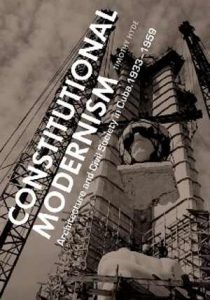نام کتاب: Constitutional Modernism – Architecture And Civil Society In Cuba, 1933-1959
نویسنده: Timothy Hyde
ویرایش: ۱
سال انتشار: ۲۰۱۴
کد ISBN کتاب: ۱۴۵۲۹۴۰۱۵۰, ۹۷۸۱۴۵۲۹۴۰۱۵۱,
فرمت: PDF
تعداد صفحه: ۳۸۳
حجم کتاب: ۵ مگابایت
کیفیت کتاب: OCR
انتشارات: University Of Minnesota Press
Description About Book Constitutional Modernism – Architecture And Civil Society In Cuba, 1933-1959 From Amazon
How does architecture make its appearance in civil society? “Constitutional Modernism” pursues this challenging question by exploring architecture, planning, and law as cultural forces. Analyzing the complex entanglements between these disciplines in the Cuban Republic, Timothy Hyde reveals how architects joined with other professionals and intellectuals in efforts to establish a stable civil society, from the promulgation of a new Cuban Constitution in 1940 up until the Cuban Revolution.
By arguing that constitutionalism was elaborated through architectural principles and practices as well as legal ones, Hyde offers a new view of architectural modernism as a political and social instrument. He contends that constitutionalism produced a decisive confluence of law and architecture, a means for planning the future of Cuba. The importance of architecture in this process is laid bare by HydeOCOs thorough scrutiny of a variety of textual, graphical, and physical artifacts. He examines constitutional articles, exhibitions, interviews, master plans, monuments, and other primary materials as acts of design.
Read from the perspective of architectural history, “Constitutional Modernism” demonstrates how the modernist concepts that developed as an international discourse before the Second World War evolved through interactions with other disciplines into a civil urbanism in Cuba. And read from the perspective of Cuban history, the book explains how not only material products such as buildings and monuments but also the immaterial methods of architecture as a cultural practice produced ideas that had consequential effects on the political circumstances of the nation.
درباره کتاب Constitutional Modernism – Architecture And Civil Society In Cuba, 1933-1959 ترجمه شده از گوگل
چگونه معماری در جامعه مدنی ظاهر می شود؟ “نوگرایی مشروطه” با کاوش در معماری ، برنامه ریزی و قانون به عنوان نیروهای فرهنگی ، این سوال چالش برانگیز را دنبال می کند. تیموتی هاید با تجزیه و تحلیل پیچیدگی های پیچیده بین این رشته ها در جمهوری کوبا ، نشان می دهد که چگونه معماران با دیگر متخصصان و روشنفکران در تلاش برای ایجاد یک جامعه مدنی پایدار ، از زمان انتشار قانون اساسی جدید کوبا در سال ۱۹۴۰ تا انقلاب کوبا ، پیوستند.
هاید با این استدلال که مشروطیت از طریق اصول و شیوه های معماری و همچنین اصول قانونی تشریح شده است ، دیدگاه جدیدی از مدرنیسم معماری به عنوان ابزاری سیاسی و اجتماعی ارائه می دهد. وی ادعا می کند که مشروطیت تلاقی قاطع قانون و معماری را به وجود آورد ، ابزاری برای برنامه ریزی آینده کوبا. اهمیت معماری در این فرآیند توسط HydeOCO ها به طور دقیق بر انواع مصنوعات متنی ، گرافیکی و فیزیکی آشکار می شود. او مقالات قانون اساسی ، نمایشگاه ها ، مصاحبه ها ، طرح های اصلی ، بناهای تاریخی و سایر مواد اولیه را به عنوان اقدامات طراحی بررسی می کند.
از دیدگاه تاریخ معماری بخوانید ، “نوگرایی مشروطه” نشان می دهد که چگونه مفاهیم مدرنیستی که به عنوان یک گفتمان بین المللی قبل از جنگ جهانی دوم توسعه یافتند ، از طریق تعاملات با سایر رشته ها به یک شهرنشینی مدنی در کوبا تبدیل شدند. و از منظر تاریخ کوبا خوانده شده ، این کتاب توضیح می دهد که چگونه نه تنها محصولات مادی مانند ساختمانها و بناهای تاریخی بلکه روشهای غیرمادی معماری به عنوان یک عمل فرهنگی ایده هایی را تولید می کند که تأثیرات مثبتی بر اوضاع سیاسی کشور دارد.
[box type=”info”]![]() جهت دسترسی به توضیحات این کتاب در Amazon اینجا کلیک کنید.
جهت دسترسی به توضیحات این کتاب در Amazon اینجا کلیک کنید.![]() در صورت خراب بودن لینک کتاب، در قسمت نظرات همین مطلب گزارش دهید.
در صورت خراب بودن لینک کتاب، در قسمت نظرات همین مطلب گزارش دهید.

